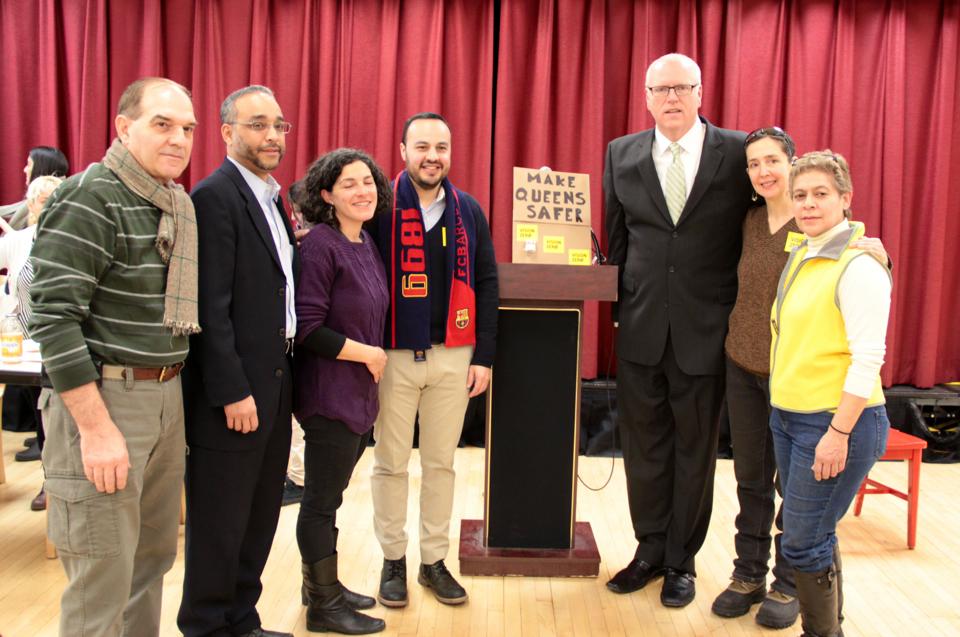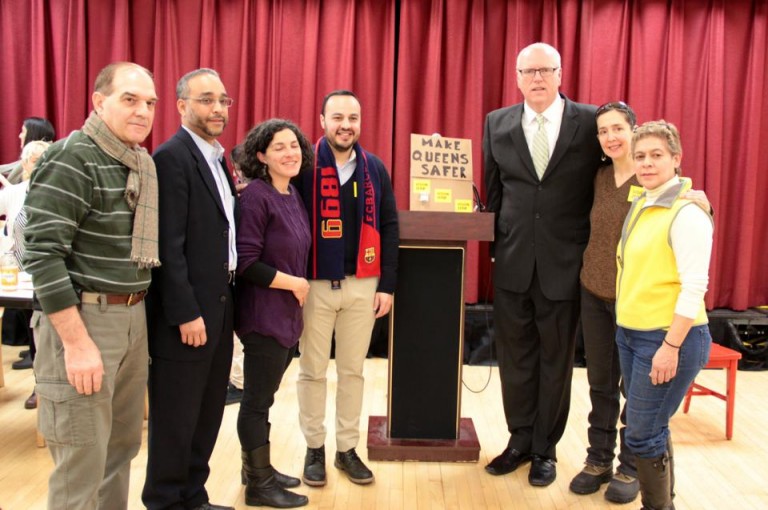
U.S. Rep. Joseph Crowley, sitting right, other elected officials, and transportation advocates met Sunday to discuss what can be done to decrease pedestrian deaths in Queens. Photo courtesy Lisa Koss
A weekend panel pushed pedestrian safety to the forefront of the political discussion as Mayor Bill de Blasio’s street safety initiative continued to take shape.
Transportation advocates from Make Queens Safer met Sunday alongside U.S. Rep. Joseph Crowley (D-Queens, Bronx) and state Assemblyman Francisco Moya (D-Corona) to grapple with staggering statistics coming from the New York Police Department. The numbers told a desperate tale of 286 deaths on New York City streets in 2013 and 93 of those coming from Queens, including 52 pedestrians.
“Since we started two months ago, Make Queens Safer has witnessed countless acts of traffic violence across our borough, and have heard from a community that has tolerated it for far too long,” said Cristina Furlong of Make Queens Safer. “Queens could be considered Ground Zero for the Vision Zero movement.”
Pedestrian safety has become a popular buzzword under the new de Blasio administration after he unveiled his “Vision Zero” initiative, which set out to reduce pedestrian deaths to zero over the next 10 years. Under the plan, which he first detailed at a Woodside intersection where an 8-year-old boy was hit and killed by a truck in December, de Blasio pledged to redesign 50 hazardous corridors and intersections each year, and street safety advocates with Transportation Alternatives said they knew some multi-lane roadways that desperately warranted consideration.
“Arterial streets make up only 10 percent of our city’s road network, but these multi-lane speedways are the site of more than half of pedestrian and cyclist fatalities,” said Paul Steely White, executive director of Transportation Alternatives. “Mayor de Blasio’s interagency Vision Zero task force must prioritize the redesign of these dangerous corridors, along with more consistent traffic enforcement, more thorough crash investigations, and the vast expansion of the 20 miles-per-hour speed limit.”
Celia Holl Castellan of Transportation Alternatives sat on the weekend panel and helped shift the discussion towards a particularly problematic pedestrian hazard – Queens Boulevard, which is often dubbed “the boulevard of death.”
In her pitch, she outlined the numbers, which included six fatalities and 492 injuries, including 32 cyclists and 120 pedestrians.
“There has long been a consensus about this street and the need for change and safety improvements,” Castellan said. “What we’re looking to do is bring political will and political action behind this consensus.”
Transportation has been working tirelessly to garner grassroots support from the ground-up with hopes to persuading elected leaders and city agencies to consider redesigning dangerous hotspots, including Queens Boulevard. Castellan said the mayor’s new safety initiative helped breathe new life into the pedestrian protection movement and the next step would be to take to Queens’ community boards this spring to deliver presentations and request they pass resolutions in their favor.
“These roadways – albeit physical barriers – are really to a certain extend serving as psychological barriers as well,” Castellan said. “It really does divide us and we think our streets should connect us. They should encourage us to stay in Queens and to live and flourish there.”
State Assemblywoman Margaret Markey (D-Maspeth) saw the consequences of inaction occur in her own district more than once – seeing a careless driver plow into a group of students on the sidewalk and another unlicensed driver taking the life of an elderly woman crossing Grand Avenue. Markey met with the city Transportation Department last week to continue exploring new measures to improve Maspeth’s main street.
“We made great progress for safety on Grand Avenue two years ago when the city finally acted to get big trucks off lower Grand and Flushing Avenues,” Markey said. “But we’ve seen recently that street safety still is not adequate.”
Markey said that DOT Borough Commissioner Dalila Hall made a commitment to quickly implement safety improvements along Grand Avenue and that more studies and possible solutions for other dangerous locations are expected over the coming months, including Grand Avenue and 69th Street and 53rd Avenue and 65th Place.
By Phil Corso

